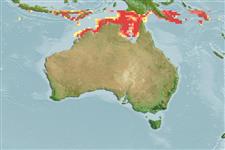Klassifizierung / Names
Namen | Synonyme | Catalog of Fishes(Gattung, Arten) | ITIS | CoL | WoRMS | Cloffa
Environment: milieu / climate zone / depth range / distribution range
Ökologie
seewasser demersal; tiefenbereich 10 - 62 m (Ref. 6871). Deep-water; 8°S - 16°S
Eastern Indian Ocean and Southwest Pacific: northern Australia, southern New Guinea and eastern Indonesia.
Length at first maturity / Size / Gewicht / Alter
Maturity: Lm 20.3, range 18 - 22 cm
Max length : 45.0 cm TL Männchen/unbestimmt; (Ref. 9840)
Found offshore on continental shelf and feeds on bony fishes and crustaceans. Litters of 1-3 pups, born at 12-14 cm WD (Ref. 114953). Ovoviviparous (Ref. 50449)
Life cycle and mating behavior
Geschlechtsreife | Fortpflanzung | Ablaichen | Eier | Fecundity | Larven
Ovoviviparous (Ref. 205). Distinct pairing with embrace (Ref. 205).
Last, P.R. and J.D. Stevens, 1994. Sharks and rays of Australia. CSIRO, Australia. 513 p. (Ref. 6871)
IUCN Rote Liste Status (Ref. 130435: Version 2024-1)
Bedrohung für Menschen
Harmless
Nutzung durch Menschen
Fischereien: nicht kommerziell
Tools
Zusatzinformationen
Download XML
Internet Quellen
Estimates based on models
Preferred temperature (Ref.
123201): 27.1 - 28.7, mean 28 °C (based on 140 cells).
Phylogenetic diversity index (Ref.
82804): PD
50 = 0.5039 [Uniqueness, from 0.5 = low to 2.0 = high].
Bayesian length-weight: a=0.01096 (0.00350 - 0.03435), b=3.12 (2.87 - 3.37), in cm total length, based on LWR estimates for this (Sub)family-body shape (Ref.
93245).
Trophic level (Ref.
69278): 3.4 ±0.3 se; based on size and trophs of closest relatives
Widerstandsfähigkeit (Ref.
120179): niedrig, Verdopplung der Population dauert 4,5 - 14 Jahre. (Assuming fecundity<100).
Fishing Vulnerability (Ref.
59153): Low to moderate vulnerability (35 of 100).
